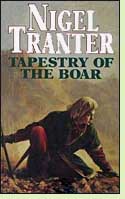Tapestry of the Boar
by Nigel Tranter
Reviewed by David Maclaine

Tapestry of the Boar is set in the late twelfth century when the lusty and hot-tempered Henry II reigned in England and Frederick Barbarossa stormed up and down Europe. But in Scotland, "Malcolm the Maiden," the sickly but devout Malcolm IV, was king. Nigel Tranter’s novel shows this slice of Scotland from the viewpoint of a minor noble, Hugh de Swinton, who by service as a scout wins the king's notice and takes a step upward in wealth and status. His cool head and good fortune in killing off some troublesome boars bring him within sight of a more enticing prize: a self-possessed young woman who is her father’s only heir. But the smitten Hugh is not yet so well-placed as to seem a likely suitor, and assorted threats to the kingdom must be surmounted before there is any chance for the triumph of true love.
This novel was my first taste of Tranter, a writer who has turned more Scottish history to fiction than anyone else. Unaware as I was of his age - he was 83 when the novel was published - his style came as a surprise. It is full of old-fashioned elaboration and sly inversions, offers a great deal of telling where most novelists would show, all with a command and charm that won me over. The plot is slender, with key battles and a crucial assassination occurring off-stage. The hero surveys a site for an important hospital foundation, tracks boars and armies, and becomes increasingly intimate with the object of his affections, who shares his interest in Pictish ruins. The great joy of the novel is Tranter’s detailed, loving account of the Scottish landscape, from the sheep-filled hills of Lothian down to the Lochs of Galloway, across to the scenic, red-cliffed coast, and up and over the great firths. A pleasant journey indeed. Thanks to Tapestry of the Boar, I’ll be seeking out more of Tranter’s work. (1994, 320 pages)
More about Tapestry of the Boar at Amazon.comOther novels by Nigel Tranter:
Margaret the Queen (1979), about the eleventh-century queen who became known as Saint Margaret of Scotland and her husband, Malcolm III. More info
David the Prince (1980), about the sons of Queen Margaret; set in the early twelfth century. More info
Lord of the Isles (1983), about Somerled, the Scottish thane who defeated the Vikings in the twelfth century. More info
Nonfiction about medieval Scotland:
The Kingship of the Scots: 842-1292 by A.A.M. Duncan (2002). More info
Outlaws of Medieval Scotland: Challenges to the Canmore Kings, 1058-1266 by R. Andrew McDonald (2003). More info
The Canmores: Kings and Queens of the Scots, 1040-1290 by Richard Oram (2002). More info
Online:
Malcolm IV at the Angry Pict website
Back to Novels of the Medieval Celts
Back to Directory of Book Reviews